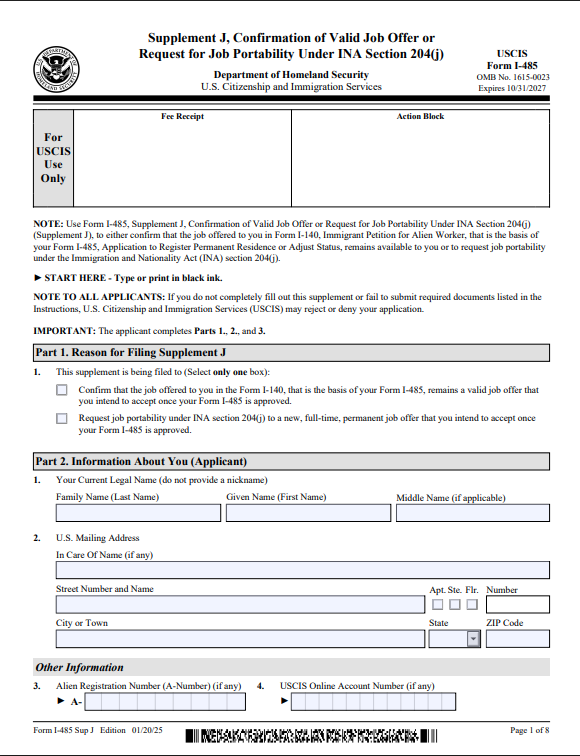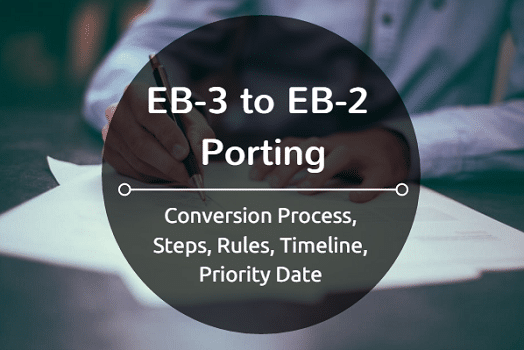Waiting for a green card can take years. If you initially applied under the EB-3 category but now qualify for an EB-2 green card, upgrading your petition can help you get your green card faster by moving into a higher-preference category. In this article, learn all about this process, commonly known as EB-3 to EB-2 porting.
Considering upgrading from EB-3 to EB-2?
Don’t risk costly delays or mistakes—consult our experienced immigration attorneys today to ensure your upgrade is done correctly and promptly.
Why Consider Upgrading from EB-3 to EB-2?
Upgrading from an EB-3 to an EB-2 green card is a method for employment-based immigrants who are eligible and want to benefit from faster processing times and more favorable visa availability.
If you choose to do this, you benefit from retaining your original EB-3 priority date. This is the date your employer filed the initial PERM labor certification.
While it isn’t a simple process to convert an approved EB-3 petition into an EB-2, it is possible. To do this, you must:
- Have a new PERM labor certification (if applicable)
- Have a new I-140 petition filed on your behalf.
- In addition, both you and the job offer must satisfy the stricter eligibility criteria for the EB-2 category, outlined below.
Eligibility Criteria for EB-2 Upgrade
Your eligibility to upgrade from EB-3 to EB-2 depends on whether you have a pending I-485 application.
Without Pending I-485
To upgrade without a pending I-485, you must:
-
Have a job offer that meets minimum EB-2 requirements, such as an advanced degree or exceptional ability.
-
Meet one of the EB-2 qualification standards:
-
Advanced degree (master’s or higher) or foreign equivalent, or
-
Bachelor’s degree plus five years of progressive work experience, or
-
Exceptional ability in science, arts, or business (with supporting evidence).
-
-
Obtain a new PERM Labor Certification reflecting the higher EB-2 job requirements (unless you qualify for a National Interest Waiver).
-
File a new EB-2 I-140 petition.
Note: This process involves filing a fresh I-140 (not interfiling). As long as your earlier EB-3 I-140 was approved, you retain your original priority date when filing the new EB-2 petition.
With Pending I-485 (Interfiling)
If your I-485 is pending, upgrading is called “Transfer of Underlying Basis” or interfiling. All of the following requirements must be met:
-
Your new EB-2 job offer must meet EB-2 criteria (advanced degree or exceptional ability etc).
-
You cannot simply reuse the EB-3 job classification. This usually requires a new PERM unless you qualify for a National Interest Waiver.
-
-
You meet EB-2 qualifications (advanced degree or bachelor’s + five years of progressive experience).
-
You have continuously maintained eligibility for adjustment of status (i.e., you have not fallen out of status).
-
Your I-485, based on the EB-3 I-140, is still pending (has not been approved, denied, or withdrawn).
-
A visa is immediately available in the EB-2 category for your priority date and country of chargeability.
-
The new EB-2 petition basis must be valid and approvable for USCIS to accept the interfiling request.
How to Upgrade from EB-3 to EB-2: Step-by-Step Guide
The steps for upgrading from EB-2 to EB-3 also differ depending on your circumstances:
A.Without Pending I-485
-
Make sure you’re eligible for EB-2
Confirm that you meet the requirements for the EB-2 category, such as holding an advanced degree or having a bachelor’s degree plus at least five years of progressive experience. Also, check that the job itself requires these qualifications. -
Get a new PERM Labor Certification
Your employer usually needs to file a new PERM with the Department of Labor to show there are no qualified U.S. workers for the EB-2 role. If you qualify for a National Interest Waiver, you can skip PERM. -
File a new EB-2 I-140 petition
Once the PERM is approved (or if it’s not needed), your employer will file a new I-140 petition in the EB-2 category. Be sure to include a copy of your earlier EB-3 I-140 approval to request that your original priority date be retained. -
Wait for the EB-2 I-140 to be approved
After filing, you’ll wait for USCIS to process and approve the petition. -
Keep track of the Visa Bulletin
You’ll need to watch the monthly Visa Bulletin to see when your EB-2 priority date becomes current. -
File your I-485 (or consular process) when eligible
Once the final action date is current for your country and priority date, you can file your adjustment of status or proceed through consular processing abroad.
Note: This process is essentially starting a new green card path in EB-2 while keeping the original priority date so you don’t lose your place in line.
B. With I-485 Pending
If you’ve already filed your I-485 based on EB-3, you can request interfiling:
-
Confirm EB-2 eligibility
Ensure you qualify for EB-2 and that the job meets the requirements. This often means filing a new PERM unless you’re eligible for a National Interest Waiver. -
File a new EB-2 I-140 petition
Your employer will file this petition, just like in the first scenario. - Check that a visa is available in EB-2
Before submitting your interfiling request, ensure your original EB-3 priority date is current in the EB-2 category for your country of chargeability. This means you keep the same priority date you got when your employer filed the initial PERM labor certification (or I-140, if no PERM was required), and you compare that date to the EB-2 Final Action Date on the Visa Bulletin. -
Submit your interfiling request to USCIS
Prepare a written request using Form I-485 Supplement J asking USCIS to transfer your I-485 to the new EB-2 basis. This usually includes:-
A cover letter explaining your request
-
A copy of the EB-2 I-140 receipt or approval notice
-
A completed Form I-485 Supplement J confirming the job offer
-
A copy of your I-485 receipt notice

-
- Wait for USCIS to process the request
USCIS will review the request and send you confirmation. Your I-485 will then be processed under the EB-2 category rather than EB-3
EB-3 to EB-2 Porting Timeline
The EB-3 to EB-2 porting timeline can be long, but if your priority date will not be current for several years, it may be worth it.
- Acquiring a new PERM Labor Certification for the new job currently takes around 16 months, more if your employer receives an audit.
- For the I-140 petition, premium processing can reduce the timeline to 15 business days for $2,805.
- Otherwise, regular processing typically takes 6-8 months according to USCIS data
- Altogether, you can expect a total processing time of around 16 – 24 months, depending on whether premium processing is used and potential audits.
EB-3 and EB-2 Priority Date Differences
The main advantage of EB-3 to EB-2 porting is more favorable priority dates. Your priority date is the date your employer filed the initial PERM labor certification (or, if PERM was not required, the date your I-140 was filed).
- With backlogs in employment-based green card petition categories, the final action dates published by the Department of State (DOS) are often several years behind the current date.
- A visa bulletin is released monthly, which provides updates on final action dates.
- If your EB-3 or EB-2 priority date is the same or earlier than the final action date in the visa bulletin, then a visa is available and you can apply for lawful permanent resident status through adjustment of status or consular processing.
Here is a screenshot of the August 2025 visa bulletin employment-based final action chart.

Currently, porting from EB-3 to EB-2 may reduce your green card waiting time by several months for certain countries. Historically, EB-2 has generally advanced faster than EB-3, with cutoff dates sometimes leading by more than three years. However, in certain periods and for specific countries, EB-3 has overtaken EB-2.
For this reason, it’s important to consult with an experienced immigration attorney before deciding whether to upgrade to EB-2, so you can evaluate the timing and eligibility in light of the latest visa bulletin trends.
EB-3 to EB-2 Conversion Rules
Because you may be waiting years for your green card, there is always the possibility that you can gain new qualifications for a higher employment-based category.
However, converting to an EB-2 is also dependent on your job rather than your newfound qualifications. This means that while education and experience are key, you will most likely be denied if your new position does not require these new qualifications.
For example, if you have acquired a master’s degree during your time waiting for an EB-3, you do not automatically qualify for an EB-3 to EB-2 porting. However, if you also acquire a position that requires an advanced degree, you have a much stronger case.
The key takeaway: To transfer from EB-3 to an EB-2 green card, you need to have a new position with higher qualifications, such as
- a large promotion with the same employer
- or by working for a new employer.
Check out our answers to the most frequent questions about the EB-2 to EB-3 India Downgrade
Staying With the Same Employer
You can upgrade from an EB-3 green card to an EB-2 green card while remaining with the same employer. However, USCIS and the Department of Labor (DOL) will carefully review that:
- The new position is a genuine, bona fide job opportunity and not created solely to reclassify you.
- It is a higher-level role that qualifies for EB-2 classification.
- For example, going from marketing analyst to marketing manager.
When evaluating the new role, USCIS considers:
-
Whether the position is different from your prior EB-3 role, such as having more responsibility, increased complexity, or more qualifications.
-
Whether the job is a bona fide, established position within the organization, rather than a role created solely to facilitate an immigration benefit.
-
Whether the role requires at least a master’s degree or equivalent (or qualifies under the “exceptional ability” criteria).
-
If the EB-2 position requires experience gained with the same employer, the DOL may closely scrutinize whether you can count that experience. To qualify, you will need to show that the new role involves substantially different duties and higher-level responsibilities compared to the EB-3 position.
Overall, the focus is on whether the new position legitimately meets EB-2 eligibility standards. Generally, moving to an EB-2 position requires the employer to obtain a new PERM labor certification and file a new I-140 immigrant petition. USCIS will review each case individually to confirm that all requirements are met.
Transferring to a Different Employer
The entire process is somewhat simplified if you can manage to find a new job with a different employer. This is because the Department of Labor is more likely to count your experience with your original employer toward your qualifications for EB-2 status.
For example, if you have worked in Company A for 4 years and try to port your EB-3 petition with the same employer, you may have a hard time using those 4 years of experience as qualifications for an EB-2.
However, if you choose to switch employers to Company B, your 4 years of experience at Company A can count toward your EB-2 green card.
No matter which route you choose, having an immigration attorney by your side who is experienced in EB-3 to EB-2 porting scenarios could potentially save you from common obstacles that others tend to encounter. Your attorney can also help you make sure that you have the best possible chance of success.
EB-2 vs EB3 Comparison
Easily the two most popular employment-based green cards, the EB-3 and EB-2, are excellent choices for immigration, depending on your employment situation:
EB-3 Green Card
Because it has the broadest requirements, the EB-3 green card is one of the most accessible green cards available. To qualify for this category, you need to be employed in one of the following groups:
- Skilled Workers- This group requires a minimum of 2 years of relevant experience.
- Professionals– For this group, you need to hold a bachelor’s degree or higher. You can also hold an equivalent degree from a foreign institution. Unfortunately, having extensive experience will not be able to replace having a bachelor’s degree.
- Unskilled/Other Workers– The jobs in this group can require less than 2 years of experience but must be permanent (meaning they cannot be temporary or contract positions)
It is important to note that all of these categories require a PERM Labor Certification. This process ensures that there are no qualified U.S. citizen workers in the area of your work that could fill the position. The job offer must also be full-time.
EB-2 Green Card
The requirements to obtain an EB-2 green card are more stringent than the EB-3. Regardless, the EB-2 is highly sought after and makes up the majority of employment-based green cards. To qualify, you must either:
- Have an advanced degree (master’s degree or higher) or its equivalent in a foreign institution. You can also have a bachelor’s degree with five years of progressive work experience in your field.
- Be able to prove that you have exceptional ability in the fields of science, art, or business. To learn what qualifies as proof of exceptional ability, you can read this EB-2 page.
For the EB-2, a PERM Labor Certification and a job offer from a U.S. employer are usually required. To have these requirements waived and self-petition, you can apply for a National Interest Waiver. This requires proof that your enterprise will be beneficial to the U.S. economy and culture.
Frequently Asked Questions
How much does the EB3 to EB2 upgrade cost?
Upgrading from EB3 to EB-2 may include the following costs:
- The I-140 petition: $715
- I-485 (if applicable): $1,440
- Costs associated with the PERM recruitment cycle: Vary
- Legal fees (if applicable): Vary, typically a few thousand dollars.
Should I consider an eb2 to eb3 downgrade?
Occasionally, EB-3 cutoff dates are more favorable than the EB-2 dates. For example, in August 2025, the cutoff dates in India for EB-3 were over 4 months ahead of the EB-2. However, cutoff dates for either category can experience dramatic changes.
These changes depend on various factors, including the number of visa applications received, annual country limits, and the overall visa quota available for each category. Because of this volatility, applicants should monitor the monthly Visa Bulletin carefully and consult with their immigration attorneys to understand how these fluctuations may impact their green card processing timelines and strategic decisions.









